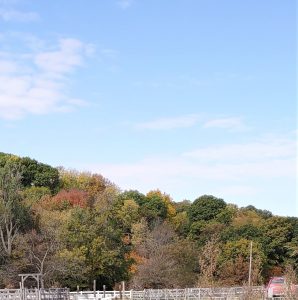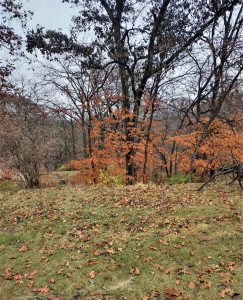Lona’s Porch
Welcome to Lona’s Porch. This is the first installment a new blog series written by Lona at HCA. Watch for occasional installments as she shares variety of observations and happenings “from the porch‘’ at Horse Creek Adventures.
Fall Color Comes Early to HCA

The top of the ridge at HCA offers a view of the forest as it’s changing colors in the fall.
Fall arrived here early. Normally our first frost is mid-October. This year it was the first of October. All my beautiful annuals were over-night brown. The flowers and leaves quickly turned to brown crinkly leaves and petals crumpled into so many pieces. Fall is bittersweet to me but especially so this year. I look forward to the cool crisp days, when eating anything pumpkin is in vogue. But it is always melancholy because the year is ending. The only consolation is the two- or three-week beautiful color show put on by nature, which didn’t happen in as grand of a way as usual this year. Not only do I love the color, but I also enjoy having the forest transform into three-dimensional work of art that I enjoy from the porch each day.
College & California
As a college student majoring in biology, I took the botany courses and could rattle off the scientific names with the best of them. But it wasn’t until I was accepted in a National Science Foundation (NSF) program in California that I began to understand the diversity that is right before our eyes. Plants tell us a story of the area where they are rooted.
My fellow program attendees and I spent that summer institute learning about plants in. We went on numerous field trips while in California where we observed the plants growing in nature. I finally fully understood that plants, like animals, fill certain niches and they truly tell us a story about where they are rooted. After that 8-week course on the west coast, I could drive down a California road, note all the diversity along the roadside and understand what it was telling me about that particular area. I came back to Omaha, drove down our roads and realized… I had never bothered to consider what the plants were telling me. Since that day, I have never see plants the same way.
Nature’s Story

No matter where you are on the property… on the porch, up on the ridge, at an off-the-grid cabin, or at Trailhead Station you’ll find a gorgeous view of the fall colors across these 173 acres in the Loess Hills.
A few years ago setting on my porch on a beautiful October day I realized that in the fall the forest has a story to tell. As I noted the many different shades of yellow and red, I began to see patterns that I never saw in the summer. I noticed the colors help delineate the various trees that make up the forest. Here at Horse Creek, I live in a valley surrounded by bluffs, the west one being a dense forest. the east bluff is where we have the “off the grid” cabins. We take our customers and their gear up in a Kawasaki Mule. In the summer, I am up and down that hill a dozen times a day. I have always noted the different shades of green but they all blended together. Now, they tell me so much more.
When I look at the woods in the fall, the first thing I see is what kind of year it has been. In our area this year, we got a three- inch rain in late August. I knew the day after the rain, it would be a beautiful fall. The intensity of the color in trees depends on how much sugar they made. Three inches of rain added up to a lot of extra sugar and color this year. Other dry years, I have waited for color only to see brown as the leaves finished their cycle.
The Story Behind The Colors…and Sugar!
Most of us think of Maples as having red leaves and Dogwoods as being purplish. For the most part that holds true because the pigments (I am forgoing the scientific names) are present in the leaves all summer just covered up by the green chlorophyll. Other trees will be yellow to red depending on the sugar content. Thanks to my years-long observations of this forest, I know where the Oak and Hickory tree groupings are in the bluffs. Usually, they are both different shades of yellow but this year I was happy to notice the Oaks were more reddish.
A New Guest at the Cabin
This year I noticed for the first time around one of the cabins, a tree that had never been memorable to me. This year it was a brilliant red! I wasn’t sure the species, but I was able to get to it to take a closer look. I found out it was a hedge tree. In our part of the world, hedge trees are a nuisance. They group numerous trunks, have thorns everywhere and will take over a forest. They grow in land that has just been disturbed or are at the edge of the forest where they have no competition. Good forest management wants to get rid of them. Settlers believed the hedge balls they formed, were useful to keep mice away. For us, they are a tree we want to cut so hikers and horse riders don’t get scratched. But this year, I finally have something good to say about them, thanks to that brilliant red color that caught my eye.
The Layers of the Forest

There are many layers in the forest here at Horse Creek Adventures. Those layers come alive with the changing colors of fall.
I always enjoy seeing the vines that grow in trees because they stand out during the fall. In the summer their leaves get lost among the others. In the fall, Creeping Jenny turns a brilliant red and decorates the tree trunk. Another vine that you see in the fall is Bittersweet with its bright red berries that are wonderful for fall decorating. And, in the fall Poison Oak and Poison Ivy are easier to avoided because their reddish leaves give their presence away.
A forest is always multi-layered with a variety of undergrowth trees. Many of these trees bloom in the spring and then disappear into the woods during the summer. Then as the year comes to an end, they emerge again when you see their colorful leaves.
The Old Oaks
One of the old sayings that I have always heard and believed is that the oaks don’t lose their leaves until the next spring. So many times I heard my mother say, “Spring is on it’s way. The Oaks are losing their leaves.” In Southwest Iowa our forest is mainly Burr Oak and Hickory. Much to my surprise the Burr Oak do lose their leaves. But they still make a fall statement as their gnarly branches silhouetted against the horizon offer some great opportunities for nature photographers.
Listen Closely To The Story Nature Tells
It never stops, what nature can tell you. This fall, as I have driven up and down the hill with guests, I hav
e noticed the many shades of grasses and begun to see some interesting things that I have not ever noticed in the summer. So, now I have something to look forward to next fall… when I will spend more time observing and enjoying the grasses, the trees, the vines… and the stories our beautiful forests can tell us.

Recent Comments